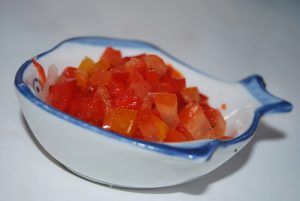Where is the Sauce?

Peru has a wealth of hot peppers and an amazing range of salsas made from them. Yet in tourist restaurant after tourist restaurant in Cuzco, Peruvian sauces are not available. It is as if they were a plague to be avoided by anyone refined, such as foreign visitors.
If you ask for hot sauce, for your soup, breakfast eggs, or your meat, you will likely be bought a small bottle of Tabasco sauce. It is as if the McIlhenney barons from Avery Island, Louisiana somehow got a stranglehold on the hot sauce business in Cuzco.
To be sure, there is nothing wrong with tabasco sauce, and the capsicum frutescens pepper from which it is made is now grown in Peru, among other countries, to meet the global demand for this industrial behemoth. And, the frutescens pepper itself may have originated in South America, perhaps even Peru.

But the Louisiana hot sauce, while great for what it is, does not equal the subtlety and refinement of the many hot sauces ground by hand every day in millions of Peruvian homes and even restaurants. Nor does the fermented tabasco pepper that is the origin of the sauce compare with the range of heat values and flavors of Peruvian hot peppers, called ajíes, known for their scent and rich, fruity flavors.
Tabasco is an excellent sauce that is carefully concocted such that every bottle shows the same high quality. Believe me, I am not criticizing it and indeed find it wonderful on red beans and rice, but it should not replace the Peruvian peppers and sauces, since they open a world of fine quality and varied tastes.

If for some strange reason one prefers industrial sauces to hand made, fresh ones, then Peru’s moguls of industry even have their own to offer you, although I like the hand made much better, even if only a simple ground of fresh peppers with salt.

At a time when salsa bars with a range of Mexican-derived hot sauces from very mild to fire hot and a range of flavors from tart to sweet fruit and roasted to raw is found in restaurant after restaurant in the United States, or at a time when salsa is replacing catchup as the preferred condiment in Anglo America, it is perplexing to find local salsa absent in its own homeland.
I suspect, as a result, that tourist tastes, or traveler’s demand, is not the reason there is either nothing or only Tabasco in many Cuzco restaurants. Rather, I bet it is the owners and cooks who still do not value their own products and foods as highly as what they think international is.
Gastón Acurio justifiably raised this post-colonial insecurity as a justification for starting his push to develop Peruvian Gastronomy as one of the finest in the world.
Too bad Cuzco’s restauranteurs and chefs seem to think a Gringo bottled sauce is better than their own uchukutas. They still need to get Gastón Acurio’s message.
In the meantime, those of us who love hot peppers and enjoy a good salsa (especially a home-made one) with our meals are imprisoned in the ideas local restauranteurs have of what we must want, rather than letting us into the secrets of their own homes and tables.
Please, Cuzco. A simple sauce of ground rocoto, or yellow aji, or a dice of limo peppers, onion and lime juice, is so much better than an aged bottle of Tabasco. May we have some Peruvian with out meals.





Hola David,
You are totally right.
Dame una direccion de correo-e y te enviare una publicacion sobre ajies.
Roberto Ugas, UNALM
Lima
Hola Roberto,
Gracias por tu comentario. Me encantará recibir la publicación sobre ajíes. Te mando mi dirección por privado.
Abrazos,
David